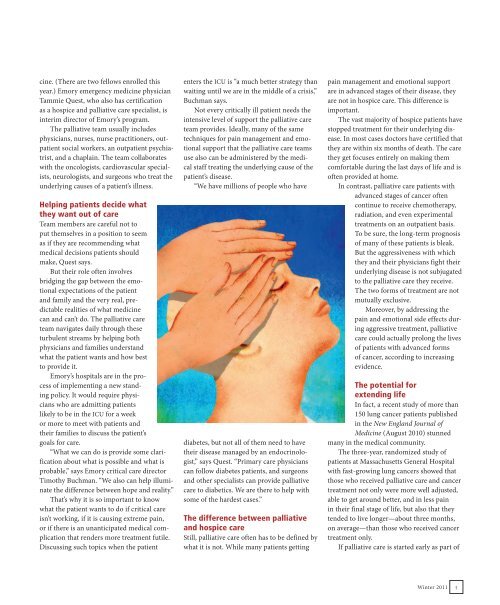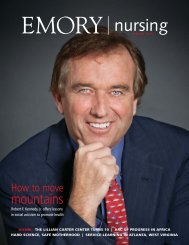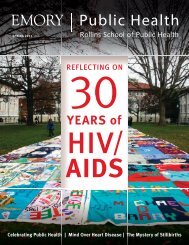returning quality to life - Woodruff Health Sciences Center - Emory ...
returning quality to life - Woodruff Health Sciences Center - Emory ...
returning quality to life - Woodruff Health Sciences Center - Emory ...
Create successful ePaper yourself
Turn your PDF publications into a flip-book with our unique Google optimized e-Paper software.
cine. (There are two fellows enrolled this<br />
year.) <strong>Emory</strong> emergency medicine physician<br />
Tammie Quest, who also has certification<br />
as a hospice and palliative care specialist, is<br />
interim direc<strong>to</strong>r of <strong>Emory</strong>’s program.<br />
The palliative team usually includes<br />
physicians, nurses, nurse practitioners, outpatient<br />
social workers, an outpatient psychiatrist,<br />
and a chaplain. The team collaborates<br />
with the oncologists, cardiovascular specialists,<br />
neurologists, and surgeons who treat the<br />
underlying causes of a patient’s illness.<br />
Helping patients decide what<br />
they want out of care<br />
Team members are careful not <strong>to</strong><br />
put themselves in a position <strong>to</strong> seem<br />
as if they are recommending what<br />
medical decisions patients should<br />
make, Quest says.<br />
But their role often involves<br />
bridging the gap between the emotional<br />
expectations of the patient<br />
and family and the very real, predictable<br />
realities of what medicine<br />
can and can’t do. The palliative care<br />
team navigates daily through these<br />
turbulent streams by helping both<br />
physicians and families understand<br />
what the patient wants and how best<br />
<strong>to</strong> provide it.<br />
<strong>Emory</strong>’s hospitals are in the process<br />
of implementing a new standing<br />
policy. It would require physicians<br />
who are admitting patients<br />
likely <strong>to</strong> be in the ICU for a week<br />
or more <strong>to</strong> meet with patients and<br />
their families <strong>to</strong> discuss the patient’s<br />
goals for care.<br />
“What we can do is provide some clarification<br />
about what is possible and what is<br />
probable,” says <strong>Emory</strong> critical care direc<strong>to</strong>r<br />
Timothy Buchman. “We also can help illuminate<br />
the difference between hope and reality.”<br />
That’s why it is so important <strong>to</strong> know<br />
what the patient wants <strong>to</strong> do if critical care<br />
isn’t working, if it is causing extreme pain,<br />
or if there is an unanticipated medical complication<br />
that renders more treatment futile.<br />
Discussing such <strong>to</strong>pics when the patient<br />
enters the ICU is “a much better strategy than<br />
waiting until we are in the middle of a crisis,”<br />
Buchman says.<br />
Not every critically ill patient needs the<br />
intensive level of support the palliative care<br />
team provides. Ideally, many of the same<br />
techniques for pain management and emotional<br />
support that the palliative care teams<br />
use also can be administered by the medical<br />
staff treating the underlying cause of the<br />
patient’s disease.<br />
“We have millions of people who have<br />
diabetes, but not all of them need <strong>to</strong> have<br />
their disease managed by an endocrinologist,”<br />
says Quest. “Primary care physicians<br />
can follow diabetes patients, and surgeons<br />
and other specialists can provide palliative<br />
care <strong>to</strong> diabetics. We are there <strong>to</strong> help with<br />
some of the hardest cases.”<br />
The difference between palliative<br />
and hospice care<br />
Still, palliative care often has <strong>to</strong> be defined by<br />
what it is not. While many patients getting<br />
pain management and emotional support<br />
are in advanced stages of their disease, they<br />
are not in hospice care. This difference is<br />
important.<br />
The vast majority of hospice patients have<br />
s<strong>to</strong>pped treatment for their underlying disease.<br />
In most cases doc<strong>to</strong>rs have certified that<br />
they are within six months of death. The care<br />
they get focuses entirely on making them<br />
comfortable during the last days of <strong>life</strong> and is<br />
often provided at home.<br />
In contrast, palliative care patients with<br />
advanced stages of cancer often<br />
continue <strong>to</strong> receive chemotherapy,<br />
radiation, and even experimental<br />
treatments on an outpatient basis.<br />
To be sure, the long-term prognosis<br />
of many of these patients is bleak.<br />
But the aggressiveness with which<br />
they and their physicians fight their<br />
underlying disease is not subjugated<br />
<strong>to</strong> the palliative care they receive.<br />
The two forms of treatment are not<br />
mutually exclusive.<br />
Moreover, by addressing the<br />
pain and emotional side effects during<br />
aggressive treatment, palliative<br />
care could actually prolong the lives<br />
of patients with advanced forms<br />
of cancer, according <strong>to</strong> increasing<br />
evidence.<br />
The potential for<br />
extending <strong>life</strong><br />
In fact, a recent study of more than<br />
150 lung cancer patients published<br />
in the New England Journal of<br />
Medicine (August 2010) stunned<br />
many in the medical community.<br />
The three-year, randomized study of<br />
patients at Massachusetts General Hospital<br />
with fast-growing lung cancers showed that<br />
those who received palliative care and cancer<br />
treatment not only were more well adjusted,<br />
able <strong>to</strong> get around better, and in less pain<br />
in their final stage of <strong>life</strong>, but also that they<br />
tended <strong>to</strong> live longer—about three months,<br />
on average—than those who received cancer<br />
treatment only.<br />
If palliative care is started early as part of<br />
Winter 2011<br />
5
















